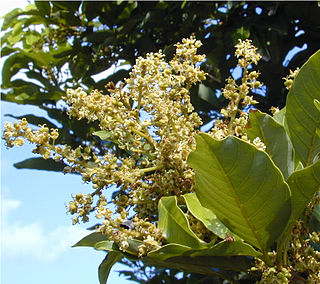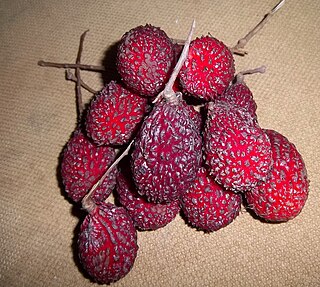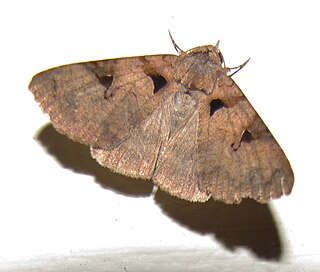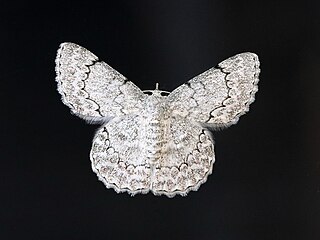
Tabebuia is a genus of flowering plants in the family Bignoniaceae. Tabebuia consists almost entirely of trees, but a few are often large shrubs. A few species produce timber, but the genus is mostly known for those that are cultivated as flowering trees.

Rambutan is a medium-sized tropical tree in the family Sapindaceae. The name also refers to the edible fruit produced by this tree. The rambutan is native to Southeast Asia. It is closely related to several other edible tropical fruits, including the lychee, longan, pulasan, and quenepa.

Nephelium is a genus of about 25 species of flowering plants in the family Sapindaceae, native to southeastern Asia.

Nephelium hypoleucum, the korlan, is a tree in the family Sapindaceae. It is in the same genus as the rambutan and also closely related to several other tropical fruits including the lychee, longan, and guinep.

Nephelium ramboutan-ake, the pulasan, is a tropical fruit in the soapberry family Sapindaceae. It is closely related to the rambutan and sometimes confused with it. Other related soapberry family fruits include lychee and longan. Usually eaten fresh, it is sweeter than the rambutan and lychee, but very rare outside Southeast Asia.
Albonectria rigidiuscula is a fungal plant pathogen. The anamorph of A. rigidiuscula the fungus Fusarium decemcellulare is associated with inflorescence wilt and vascular necrosis in fruit tree crops such as Mango, Longan and Rambutan. F. decemcellulare causes a disease known as cushion gall in Theobroma cacao and other tropical trees.
Nephelium costatum is a species of plant in the family Sapindaceae. It is a tree endemic to Peninsular Malaysia. It is threatened by habitat loss.
Nephelium hamulatum is a species of plant in the family Sapindaceae. It is a tree endemic to Peninsular Malaysia. It is threatened by habitat loss.
Nephelium juglandifolium is a species of shrub. The drupe fruit is not as round as the other fruits within this genus. The shrub produces small flowers. The plants are grown in parks as decorative ornamental plants. In its natural environment, N. juglandifolium grows in lowland forests. It is usually 30m tall when fully grown.

Nephelium xerospermoides, the hairless rambutan, is a species closely related to the rambutan. The drupe fruit has a flavor similar to rambutan. The fruit does not have any hair-like spines, hence its common name. They can be eaten freshly picked from the tree. They are not commonly grown or harvested for commercial use.

Avatha discolor is a species of moth of the family Erebidae. It is found from the Indo-Australian and Pacific tropics to as far east as Henderson Island.

Pingasa chlora, the white looper moth or flower-eating caterpillar, is a species of moth of the family Geometridae first described by Caspar Stoll in 1782. It is found in Sundaland, the Philippines, Sulawesi and from the Moluccas to Queensland, Australia.
Adoxophyes privatana, the appleleaf-curling moth, is a moth of the family Tortricidae. The species was first described by Francis Walker in 1863. It is native to south-east Asia, where it has been recorded from Taiwan, Hong Kong, Hainan in China, Nepal, India, Sri-Lanka, Thailand, Vietnam, western Malaysia, Singapore, Sumatra, Java, Borneo, the Philippines and the Chagos Archipelago. It is an accidental introduction in Great Britain.
Conopomorpha litchiella is a moth of the family Gracillariidae. It is known from Australia, China (Fujian), India, Malaysia (Selangor), Nepal, Taiwan and Thailand.

Alectryon tomentosus, commonly known as the hairy birds eye, red jacket or woolly rambutan, is a rainforest tree of the family Sapindaceae found in eastern Australia. The specific epithet tomentosus refers to the hairy leaves and hairy young shoots.

Roseodendron is a genus of flowering plants in the family Bignoniaceae. It consists of two species, Roseodendron donnell-smithii and Roseodendron chryseum. The type species for the genus is R. donnell-smithii. Both species are cultivated as ornamentals for their numerous, large, yellow flowers.
Homona eductana is a species of moth of the family Tortricidae. It is found in India, Thailand, Malaysia, Singapore and China.
Xerospermum is a small genus of Asian plants of the family Sapindaceae.
Dendrobium chryseum is a species of flowering plant in the family Orchidaceae. It is native to the Himalayas, mainland South East Asia, south-central China, and Taiwan. It is one of over 1,600 species in the genus Dendrobium.










